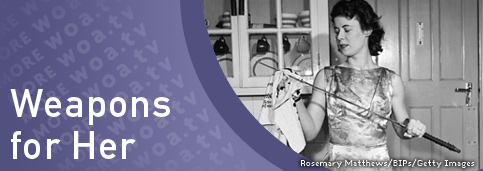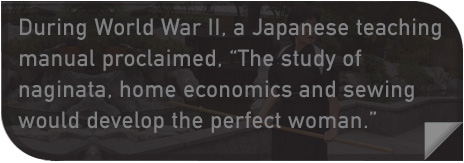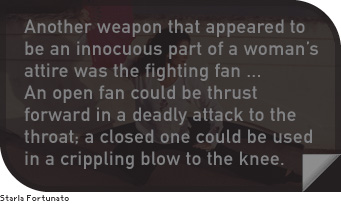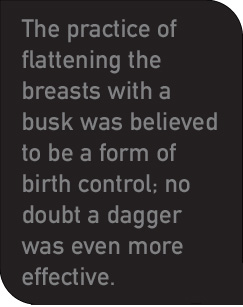
When Lizzie Borden allegedly took an axe to give her stepmother 40 whacks, her weapon of choice was a favorite of the Amazons—and with good reason. A weapon as short, sharp and top-heavy as an axe doesn’t require a lot of forearm strength to cause a lot a damage: A thin spinster could simply throw her weight behind the hunk of metal and let the axe do the job. In the hands of a woman as fit as an Amazon warrior, there’s no limit to the damage that weapon could do. The upper-body strength a man might use to overpower a woman is useless against the momentum of a forward-flying axe: his options are duck fast or die.
The most effective weapon for a given individual compensates for its wielder’s weaknesses and maximizes her strengths. A smallsword, which best aids a fighter with agile fingers and powerful legs, suits most women better than, say, a cutlass, which requires more forearm strength to control. Long-handled weapons that keep an opponent at a distance also work well for women, who are often smaller than their male opponents and could be overpowered at closer range.
Historically, weapon choice has been an individual matter for women warriors, with many coming from cultures with age-old traditions of women’s weapons. The naginata of Japan is occasionally referred to as the “woman’s spear”—but not because there’s anything dainty about it. A type of halberd, a naginata is a long wood or bamboo pole with a curved single-edged blade at the head. The pole can be anywhere from 5 to 9 feet long, and the curved blade ranges from 1 to 2 feet in length. The length and light weight of the weapon are advantageous to women warriors.
Many scholars believe that the naginata evolved from a simple farming tool in Japan, making it something of a house weapon. But skeptics point out that the Chinese also used a halberdlike weapon around the time the naginata appeared on the scene (roughly, 200 BCE). Whatever its origin, scholars and martial artists agree that women used the weapon extensively.

The naginata is used in a sweeping circular motion that is purely offensive. Used both on horseback and on foot, this weapon was highly effective at keeping sword-wielders at a distance and could sever opponents’ limbs with one slash. Legendary warriors Tomoe Gozen and Itagaki went to battle spinning naginatas like pinwheels. Samurai wives left behind by traveling husbands used the weapon to defend their homes. Around the 1400s, samurai warriors stopped using the naginata, giving it over entirely to women, leading to its fame as the “woman’s spear.” Until the 1900s, naginata training was the only martial art women in Japan were allowed to practice. During World War II, a Japanese teaching manual proclaimed, “The study of naginata, home economics and sewing would develop the perfect woman.” Today, the weapon is again used by both genders.
 Japan has made several other contributions to the world of womanly weaponry, most of them used by the female ninjas known as kunoichi, who began slipping through the shadows in the 1500s. The kunoichi’s secret weapons included poisons, blinding powders and stealth weapons like the kushi (hair comb), kasa (umbrella), kakute (spiked ring), nekote (steel claws or fingernails) and hari (sharpened needle). These dual-function weapons went mostly undetected on kunoichi disguised as dewy-eyed geishas, but each could be used to kill, and the kunoichi trained hard to do so, quickly and quietly. Worn as jewelry, the kakute made it easy to slice a throat; the kushi could be holding hair one moment and stabbing a vital organ the next.
Japan has made several other contributions to the world of womanly weaponry, most of them used by the female ninjas known as kunoichi, who began slipping through the shadows in the 1500s. The kunoichi’s secret weapons included poisons, blinding powders and stealth weapons like the kushi (hair comb), kasa (umbrella), kakute (spiked ring), nekote (steel claws or fingernails) and hari (sharpened needle). These dual-function weapons went mostly undetected on kunoichi disguised as dewy-eyed geishas, but each could be used to kill, and the kunoichi trained hard to do so, quickly and quietly. Worn as jewelry, the kakute made it easy to slice a throat; the kushi could be holding hair one moment and stabbing a vital organ the next.
Another weapon that appeared to be an innocuous part of a woman’s attire was the fighting fan. Sometimes called the iron war fan (or gunsen), the fighting fan was used throughout Japan and China. This normal-looking accessory was made of heavily lacquered metal, which gave it the weight and power of a policeman’s club. An open fan could be thrust forward in a deadly attack to the throat; a closed one could be used in a crippling blow to the knee. More complicated versions of the fighting fan concealed a tanto.
 Women’s weapons were not limited to the Far East. From the Amazon warriors of ancient Greece to the female Vikings and Saxons of medieval Europe, from Lizzie Borden to eighteenth-century pirates such as Mary Read, the battle-axe has become synonymous with a certain type of Western woman—so much so that the domineering women are often called “battle-axes.” And the strength of the weapon is incredible—once an axe gets moving, it doesn’t matter if a man or a woman swung it; the weight of the axe head will plunge through skulls.
Women’s weapons were not limited to the Far East. From the Amazon warriors of ancient Greece to the female Vikings and Saxons of medieval Europe, from Lizzie Borden to eighteenth-century pirates such as Mary Read, the battle-axe has become synonymous with a certain type of Western woman—so much so that the domineering women are often called “battle-axes.” And the strength of the weapon is incredible—once an axe gets moving, it doesn’t matter if a man or a woman swung it; the weight of the axe head will plunge through skulls.
The double-headed axe known as a labrys was designed specifically for women. Primarily used in rituals, the labrys was associated with the Mother Goddess of the ancient Minoans. Legend credits the Amazon queen Penthesilea with the invention of the labrys, and ancient artwork often depicts Amazons brandishing the weapon.
A popular women’s weapon in Renaissance England was the modest bodice dagger. The fashion was inspired by a type of bodice worn by the Virgin Queen, Elizabeth I; this upper part of a women’s dress showed no cleavage and featured an iron rod known as a busk down the front to flatten a woman's bosom into a manlike shape. Some women replaced the busk with a small dagger to counter uninvited gropes. When an unwanted advance was made, a woman would simply pull the dagger out of her dress for use on her offender. The practice of flattening the breasts with a busk was also believed to be a form of birth control, since it was thought that crushing the breasts prevented pregnancy. No doubt a dagger was even more effective.
Whatever a woman’s reason for entering into combat, a well-suited arsenal has been available through the ages. Naginata, fighting fan, axe or bodice dagger—they all maximize a woman’s strengths to get the job done.
:: Roberta Brown
Weapons for Her Selected Sources
|









